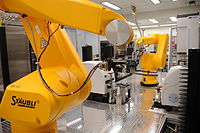
Photo from wikipedia
Developments in High Throughput Screening aim at maximizing the number of samples per time and reducing the cost per sample, e.g., by applying very small sample volumes. The ultimate technological… Click to show full abstract
Developments in High Throughput Screening aim at maximizing the number of samples per time and reducing the cost per sample, e.g., by applying very small sample volumes. The ultimate technological step in miniaturization is moving from microtiter plate wells to droplets, and from batch-wise characterization to the continuous preparation and analysis of samples. A range of drop-based microfluidic screening platforms has emerged that benefit from drop-formation rates of thousands per second, perfect drop size uniformity, plug-flow and compartmentalization, and the possibility of continuously analyzing a train of drops. However, after many years of intensive research, only few commercial applications have been developed and substantial development in the field is still required to make them reliable and broadly applicable. Can academic research achieve this, given that most of the fundamental concepts have been described already, making it hard to publish a big story? Can start-up companies raise enough money to overcome the technical issues of drop-based screening platforms? This contribution addresses the question, focusing on how the different stakeholders in the field should interact so that disillusionment will not put a premature end to the development of drop-based screening technologies.
Journal Title: Micromachines
Year Published: 2017
Link to full text (if available)
Share on Social Media: Sign Up to like & get
recommendations!